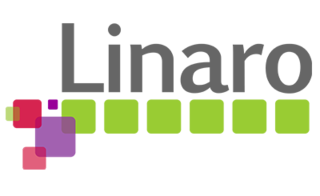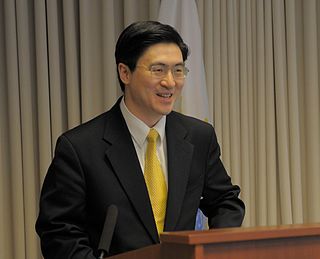
Intel Corporation is an American multinational corporation and technology company headquartered in Santa Clara, California. It is one of the world's largest semiconductor chip manufacturers by revenue. Intel supplies microprocessors for most manufacturers of computer systems, and is one of the developers of the x86 series of instruction sets found in most personal computers (PCs). Intel also manufactures chipsets, network interface controllers, flash memory, graphics processing units (GPUs), field-programmable gate arrays (FPGAs), and other devices related to communications and computing.

The Open Systems Interconnection model is a reference model from the International Organization for Standardization (ISO) that "provides a common basis for the coordination of standards development for the purpose of systems interconnection." In the OSI reference model, the communications between systems are split into seven different abstraction layers: Physical, Data Link, Network, Transport, Session, Presentation, and Application.

Windows IoT, short for Windows Internet of Things and formerly known as Windows Embedded, is a family of operating systems from Microsoft designed for use in embedded systems. Microsoft has three different subfamilies of operating systems for embedded devices targeting a wide market, ranging from small-footprint, real-time devices to point of sale (POS) devices like kiosks. Windows Embedded operating systems are available to original equipment manufacturers (OEMs), who make it available to end users preloaded with their hardware, in addition to volume license customers in some cases.
The Internet of things (IoT) describes devices with sensors, processing ability, software and other technologies that connect and exchange data with other devices and systems over the Internet or other communications networks. The Internet of things encompasses electronics, communication, and computer science engineering. "Internet of things" has been considered a misnomer because devices do not need to be connected to the public internet; they only need to be connected to a network and be individually addressable.

Arm Holdings plc is a British semiconductor and software design company based in Cambridge, England, whose primary business is the design of central processing unit (CPU) cores that implement the ARM architecture family of instruction sets. It also designs other chips, provides software development tools under the DS-5, RealView and Keil brands, and provides systems and platforms, system-on-a-chip (SoC) infrastructure and software. As a "holding" company, it also holds shares of other companies. Since 2016, it has been majority owned by Japanese conglomerate SoftBank Group.

Linaro is an engineering organization that works on free and open-source software such as the Linux kernel, the GNU Compiler Collection (GCC), QEMU, power management, graphics and multimedia interfaces for the ARM family of instruction sets and implementations thereof as well as for the Heterogeneous System Architecture (HSA). The company provides a collaborative engineering forum for companies to share engineering resources and funding to solve common problems on ARM software. In addition to Linaro's collaborative engineering forum, Linaro also works with companies on a one-to-one basis through its Services division.

The Open Compute Project (OCP) is an organization that shares designs of data center products and best practices among companies, including Arm, Meta, IBM, Wiwynn, Intel, Nokia, Google, Microsoft, Seagate Technology, Dell, Rackspace, Hewlett Packard Enterprise, NVIDIA, Cisco, Goldman Sachs, Fidelity, Lenovo and Alibaba Group.
The following outline is provided as an overview of and topical guide to computing:

Hélder Fragueiro Antunes is a Portuguese-American executive, computer scientist, and former racecar driver. A Cisco Systems executive for over twenty years, as well as founder and first Chairman of the OpenFog Consortium, Antunes currently serves as Chief Executive Officer of Crowdkeep. His car racing career in the 1980s and '90s made him one of the most preeminent open road racers at the time.

Mung Chiang is a Chinese American electrical engineer and academic administrator who has been serving as the current and 13th president of Purdue University since 2023. He is the youngest president of a top-50 American university in recent history.

Intel Galileo is the first in a line of Arduino-certified development boards based on Intel x86 architecture and is designed for the maker and education communities. Intel released two versions of Galileo, referred to as Gen 1 and Gen 2. These development boards are sometimes called "Breakout boards".
AllJoyn is an open source software framework that allows compatible devices and applications to find each other, communicate and collaborate across the boundaries of product category, platform, brand, and connection type. Originally the AllSeen Alliance promoted the project, from 2013 until 2016 when the alliance merged with the Open Connectivity Foundation (OCF). In 2018 the source code became hosted by GitHub.
Fog computing or fog networking, also known as fogging, is an architecture that uses edge devices to carry out a substantial amount of computation, storage, and communication locally and routed over the Internet backbone.

The Industry IoT Consortium (IIC) (previously the Industrial Internet Consortium) is an open-member organization and a program of the Object Management Group (OMG). Founded by AT&T, Cisco, General Electric, IBM, and Intel in March 2014, the IIC was formed to accelerate the development, adoption, and widespread use of interconnected machines, devices, and intelligent analytics through catalyzing and coordinating the priorities and key technologies of the Industrial Internet of Things (IIoT). No products or services are sold.
The IoTivity is an open source framework created to standardize inter-device connections for the IoT. Any individual or company can contribute to the project, and this may influence OCF standards indirectly. However, being a member of the OCF can benefit from patent cross-licensing protection.
The Alliance for Open Media (AOMedia) is a non-profit industry consortium headquartered in Wakefield, Massachusetts and formed to develop open, royalty-free technology for multimedia delivery. It uses the ideas and principles of open web standard development to create video standards that can serve as alternatives to the hitherto dominant standards of the Moving Picture Experts Group (MPEG).
The Open Connectivity Foundation (OCF) is an industry organization to develop standards, promote a set of interoperability guidelines, and provide a certification program for devices involved in the Internet of things (IoT). By 2016 it claimed to be one of the biggest industrial connectivity standards organizations for IoT. Its membership includes Samsung Electronics, Intel, Microsoft, Qualcomm and Electrolux.
The Gen-Z Consortium is a trade group of technology vendors involved in designing CPUs, random access memory, servers, storage, and accelerators. The goal was to design an open and royalty-free "memory-semantic" bus protocol, which is not limited by the memory controller of a CPU, to be used in either a switched fabric or a point-to-point device link on a standard connector.
Coherent Accelerator Processor Interface (CAPI), is a high-speed processor expansion bus standard for use in large data center computers, initially designed to be layered on top of PCI Express, for directly connecting central processing units (CPUs) to external accelerators like graphics processing units (GPUs), ASICs, FPGAs or fast storage. It offers low latency, high speed, direct memory access connectivity between devices of different instruction set architectures.
Compute Express Link (CXL) is an open standard for high-speed, high capacity central processing unit (CPU)-to-device and CPU-to-memory connections, designed for high performance data center computers. CXL is built on the serial PCI Express (PCIe) physical and electrical interface and includes PCIe-based block input/output protocol (CXL.io) and new cache-coherent protocols for accessing system memory (CXL.cache) and device memory (CXL.mem). The serial communication and pooling capabilities allows CXL memory to overcome performance and socket packaging limitations of common DIMM memory when implementing high storage capacities.











